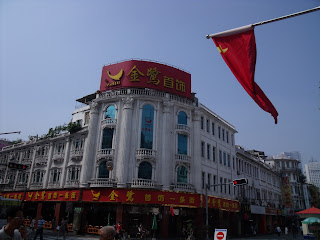Our Chinese forefathers hail from South China (the provinces of Fujian, Guangdong and Hainan), as evidenced by the dialects spoken here, Hokkien, Teochew, Hainanese, Cantonese and Hakka.
Just some scenes of Chaozhou (a district within Guangdong province) and Fujian during my recent sojourn there.
Guangji Bridge in Chaozhou, China, spans the Han River, an important waterway between eastern Guangdong and Fujian province. Interesting bit about this 12th century bridge is that the centre of the bridge is formed by boats moored to join up eastern and western piers daily between 10am and 5pm, so it's called a "floating bridge".
In the same vicinity is Guangji Men, one of four doors in this fortress like wall which stretches 2100 metres from end to end. This is the old city wall of Chaozhou prefecture built in the Ming Dynasty (1370AD). There are seven gates each with a tower on it.
Tiger Stream Rock (Huxiyan) is built out of a rocky outcrop on the outskirts of Xiamen (formerly known as Amoy, in the 19th century). You can see rock overhanging roofs. Once a tiger lived in a stone cave here, hence the name. Donglin Temple (Rock temple) is here. Digressing, Amoy then was a treaty port and a foreign community was established on the island off it called Gulangyu.
A Victorian style house on Gulangyu island. In the 1860s foreign representatives built churches, consulates, villas on the island. The island was designated an international settlement for Europeans and the Japanese in 1903. There is no traffic on the island except for a tram that goes around.
Zhongshan street is a shopping area in Xiamen. And Xiamen on the coast of the South China Sea across from Taiwan is modern, modern modern. Well, as with other modern Asian cities, the new and the old buildings cohabit side by side.
+guangji+bridge.JPG)



